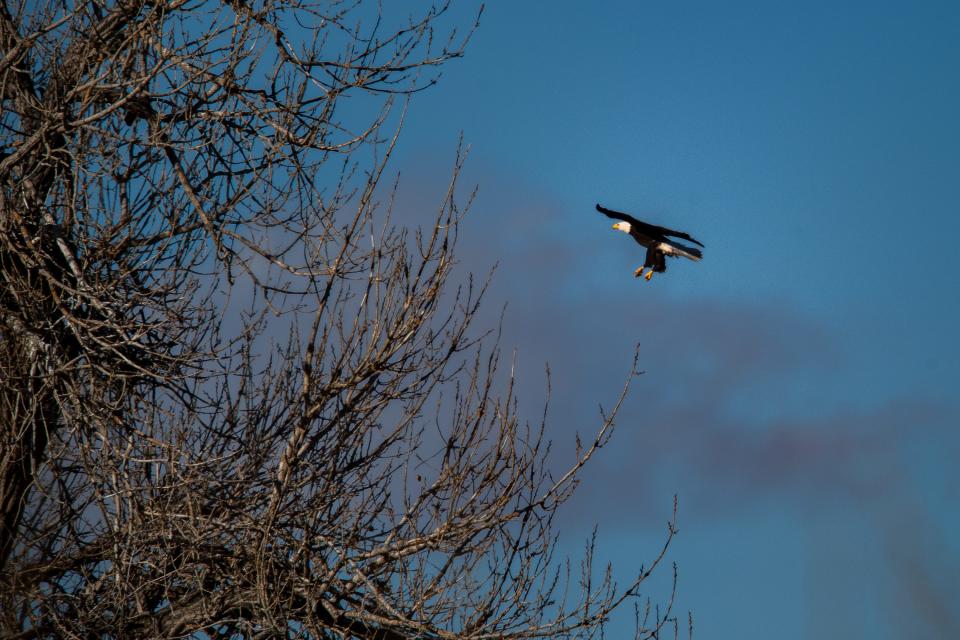Colorado's bald eagles soar to new heights despite bird flu setback
When a highly pathogenic strain of avian flu started killing tens of thousands of waterfowl in the state in 2022, Colorado raptor biologists feared it also would heavily impact bald eagles and hawks.
What those biologists are finding is that while the state's raptors did take a hit in deaths and nesting failure at first, it wasn't nearly as much as initially feared. They also are seeing raptor numbers rebound better than expected in Colorado.
Colorado Parks and Wildlife is reporting the state is home to more than 300 occupied bald eagle nests, the highest number on record.
Reesa Conrey, Colorado Parks and Wildlife's avian researcher who is leading a monitoring program of bald eagles along the Front Range, said nesting pairs of bald eagles are increasing every year, save for 2022 when highly pathogenic avian influenza reduced nest success in her study area by 20%.
"I keep thinking we will reach carrying capacity and there will be no more good sites, but we apparently haven't reached that point yet,'' she said. "Reproductivity success in nests is high. My assumption is food resources, mainly fish, waterfowl and prairie dogs, are still sufficient to support more eagles."
Conrey said only a handful of bald eagles are known to have died from avian flu in her study area. She said the list of raptors dying from avian flu was long in 2022 but much shorter in 2023.
"We don't know why bald eagles have come through avian influenza, but they can be long lived and it appears the older ones may have developed a resistance to it.,'' she said. "It affects nestlings more and that may have to do with a lack of immunity."
Her study has shown more nests being used and new nests started in the study area, especially along the Poudre River. She said among the bald eagles it has tagged, some are staying in the area while others have moved north to the Red Feather Lakes area and into Wyoming.
Colorado Parks and Wildlife's recent discovery of bald eagles using a nest near the Poudre River delayed construction of a segment of the Poudre Trail that was to start in April until August, after the chicks have left the nest.
There are around 100 known bald eagle nests along the Front Range from Denver to the Wyoming state line. Most nests are found in large cottonwood trees near bodies of water.
Conrey said 11 of the 39 tagged bald eagles since July 2020 have died, which is higher than expected. She said electrocution has been the main cause of death, followed by bald eagles being struck by vehicles.
She gave credit to private landowners and volunteers for aiding in the ongoing bald eagle study.

Hawks and owls also showing a rebound after avian flu impacted the population
Mike Tincher, rehabilitation and research coordinator at the Rocky Mountain Raptor Program in Fort Collins, said the center was seeing high numbers of red-tailed hawks and great horned owls dying in the early stages of the avian flu outbreak in 2022 and early 2023.
Since then, he said, the population of those raptors as well as others such as Cooper's hawks and northern harriers have rebounded.
"We expected to see a resurgence (of the virus) in the summer of 2023, but the impact was minimal,'' he said. "We had our first case of avian flu in raptors in the middle of October (2023) and through last year only saw eight cases. We've seen only one this year and it was in January.''
He suspects the population rebound might be because the virus is becoming less virulent and more raptors have acquired immunity. A study is being conducted to determine how raptors are living with and surviving avian flu.
He said death in waterfowl, which saw the greatest impact, was significantly reduced during last fall's migration in Colorado.
Canada geese in the Fort Collins area, including on Sheldon Lake at City Park, died from the virus.
Concern now focuses on avian flu infecting dairy cattle for the first time
There is growing concern with the recent announcement that avian flu for the first time has infected dairy cattle in eight states: Idaho, Kansas, Michigan, New Mexico, North Carolina, Ohio, Texas and South Dakota, according to the U.S. Department of Agriculture.
The U.S. Food and Drug Administration said despite the discovery, there continues to be no risk to consumer health of the commercial milk supply.
Colorado saw large outbreaks of avian flu in commercial chicken operations with 17 counties reporting infections in commercial and backyard operations since 2022. That resulted in producers euthanizing 6.3 million chickens, according to the Colorado Department of Agriculture.
Weld County has the most flocks impacted, 17, while Larimer County has three.
Larimer County leads Colorado in wild mammals with avian flu
Avian flu has also been detected in mammals.
As of April 1, Colorado has reported 19 wild mammals infected, according to the U.S. Department of Agriculture Animal and Plant Health Inspection Service.
Those include eight skunks, four mountain lions, four red foxes, two bobcats and a black bear.
Larimer County has the most reported mammals with five, all skunks, among Colorado counties. All of those were detected in 2023.
All mammal cases occurred on 2022 and 2023. There have been no reported cases statewide in mammals in 2024.
This article originally appeared on Fort Collins Coloradoan: What happened to Colorado's bald eagles after bird flu went through?

